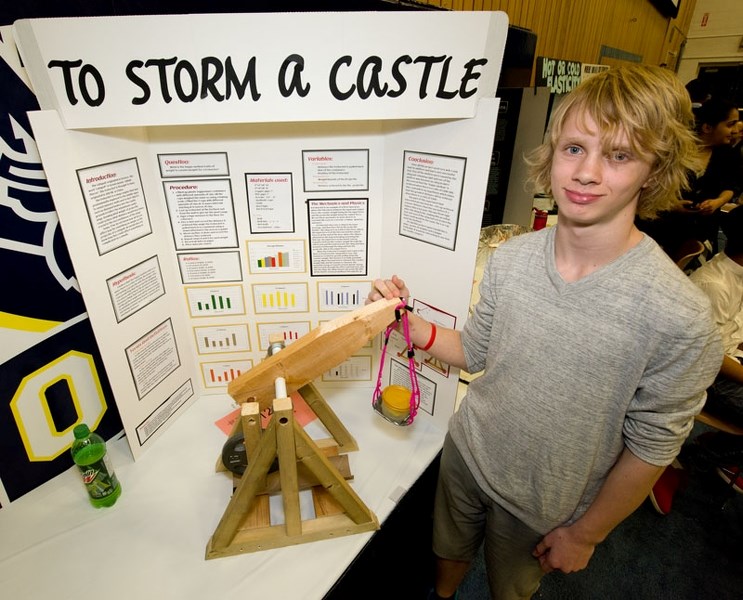By Kevin Ma
St. Albert-area students snagged some serious cash for their work last weekend at a regional science fair using sunscreen, sight, and siege warfare.
Some 281 students from across northern Alberta pushed the frontiers of human knowledge last weekend as part of the Edmonton Regional Science Fair at the Northern Alberta Institute of Technology.
The annual event has students pursue an independent scientific research project and present the results of their experiments in order to encourage them to get into science and engineering careers. Top performers win cash prizes and a spot at the national science fair in Montreal this May.
St. Albert and Sturgeon County had at least 15 teams in this year's fair, many of which were from Sir George Simpson.
Simpson student Alec Tinga built a model trebuchet to determine the optimal weight ratio with which to launch a projectile.
"I enjoy building stuff and I like throwing stuff," he explained, and he was fascinated with medieval siege weaponry.
The trebuchet was invented in around 300 BC in China as an upgrade to the catapult, he explained. Instead of using one arm and a fixed weight, the trebuchet has a suspended weight and a sling that effectively doubles the length of the throwing arm, making it more effective at launching projectiles.
Tinga tested his trebuchet with projectiles of different weights in his basement to eliminate wind issues, flinging them anywhere from 200 to negative-60 inches – the latter was a misfire and would have been a problem for the army firing it, he noted.
His results suggest that a 1:140 projectile-to-counterweight ratio would yield the best result for any aspiring siege commander.
When asked if he planned to build a bigger model with which to assail his school in the future, he said, "Not yet, but maybe."
Hannah Hughes of Legal's école Citadelle wanted to know what parts of the face the brain paid the most attention to when it came to recognizing others. To do so, she took pictures of her classmates and checked if students could recognize each other based just on pictures of the mouths or eyes. She also printed monochrome photos of the eyes to see if eye colour was important.
"It was a really cool experiment," she said, and she had no shortage of volunteers to take part.
To her surprise, she found that the area around the eyes, and not the eyes themselves, seemed to hold people's attention the most as they were the most important factor in identifying people.
"People found it very easy to recognise people without having to see the colour of their eyes," she said, as the monochrome photos were just as easy to identify as the colour ones.
This suggests that a domino mask could actually help conceal a superhero's identity despite covering up just the area around a person's eyes, she said. But since all parts of the face help in identification, she said a full facemask would be more effective.
Hughes won $305 for her experiment.
Simpson students Hannah Veinot and Caitlin Sandilands won $150 for their comparative study of different types of sunscreen.
"It's something everyone uses at least once in their life," Veinot said of sunscreen, and they wanted to find out which brand worked best.
Veinot and Sandilands smudged/sprayed nine brands of sunscreen onto UV-sensitive plates, exposed the plates to a specific amount of UV light, and used a fluorometer to determine how much light got through.
Veinot said the creams were much better at blocking light than the sprays, as they created a solid patch of protection instead of a scattershot of droplets. The two organic sunscreens they tested outperformed the inorganic ones, but they're not sure why.
They also found that the protective powers of SPF 60 sunscreens were not significantly greater than those of SPF 30 ones.
"It's definitely not the double of an SPF of 30," Sandilands said.
This suggests that high-SPF sunscreens might be a bit of a rip-off, she said. She plans to stick with SPF 30 as a result.
Marguerite d'Youville student Kevin Vossen, who experimented with growing algae for biofuel as part of his project, said the science fair was a fun way to actually apply the science lessons you learn in school. Anyone with a passion for science should give it a shot.
"You're bound to learn something … (and) not only that, you may teach somebody something as well."
Full science fair results are available at ersf.ca under the Log In tab.




